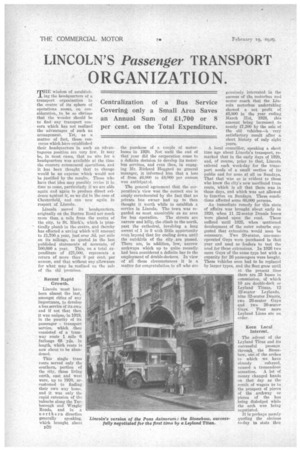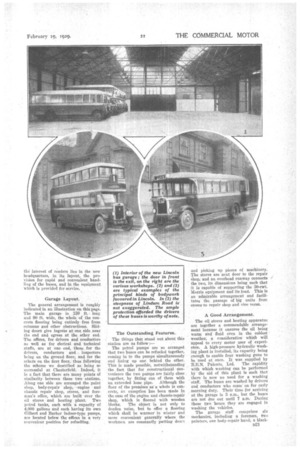LINCOLN'S Passenger TRANSPORT
Page 110

Page 111

Page 112

If you've noticed an error in this article please click here to report it so we can fix it.
ORGANIZATION.
/7111.11 wisdom of establishing tbe headquarters of a transport organization
the. centre of its sphere of operations seems, on consideration, .to be so obvious that the wonder should be to find any transport concern which has not realized the advantages of such an arrangement. Yet, as a matter of fact, those con cerns which have established their headquarters in such an advantageous position are very few. It may be, in most cases, that no site for a headquarters was available at the time the concern commenced operations, and it has been thought that to change
would be an expense which -would not
be justified by the results. Those who
have that idea may possibly revise it in
time to come, particularly if we are able again and again to produce direct evi dence against it, as we did in he case of
Chesterfield, and can now again in
respect of Lincoln.
Lincoln moved . its headquarters, originally on the Burton Road not. much more than a mile from the centre of the city. to St. Mark's, which is practically
pluMb in the centre, and thereby has effected a saving which will amount to 11,700 a year, just over .Sd. per mile on its mileage, as quoted in the last published statements of accounts, of 500,000 a year. This, on a total ex-. penditure of 01,009, represents a return of more than 8 per cant per annum, and that without any allowance for what may be realized oa the sale of the old premises.
Recent Rapid Growth.
Lincoln 'must have been almost the last, amongst cities of any importance, to develop a bus service of its own and if not that then It was unique, in 1919, iu the paucity of its :passenger transport service, which .then consisted of a tram..
• way route 1 mile 6 furlongs 68 yds. in length, which route is now about to be shalt&rued.
This single train route served only the southern, portion of the city, those living north, east and west were, up to 1920,. accustomed to Ending their own way home. and it was only the • rapid extension of the Suburbs along the Yarborough and Wragby Roads, and in a northern directios generally speaking, -which brought about
D20 the purchase of a couple of motorbuses in 1920. Not until the end of that year did the corporation come to a definite decision to develop its motorbus services and even then, in engaging Mr. Richard Efoggard as general manager, it informed him that a loss of from £6,000 to 18,000 per annum was anticipated, The 'general 'agreement that the corporation's view was the correct one is amply corroborated by the fact that no private bus owner had up to then thought it ivorth while to establish a service in Lincoln. The town was regarded as most unsuitable as an area for bus operation. The streets are narrow and hilly, the climb to the north, past the cathedral, involving . a long ascent of 1 in 9 with little opportunity even beyond that for cooling down until the outskirts of the city are passed. There are, in addition, low, narrow archways which up to quite recently had been considered a definite bar to the employment of double-deckers. In view of all these circumstances it is a matter for congratulation to all who are
genuinely interested in the success of the motorbus and motor coach that the Lincoln motorbus undertaking bowed. a net profit of 16,800 in the year ending March 31st, 1928, this amount being increased to nearly 17,200 by the sale of the old vehicles—k • very satisfactory result after a short history of only eight years.
A local councillor, speaking a short time ago about Lincoln's transport, remarked that in the early days of 1920, and, a course, prior to that, Lincoln catered each week-day for the transport needs of a small section of its public and for none at all on Sundays. That that' wasso is evident to those who knew the city's now moribund tram route, which is all that there was in those days, and which was not allowed to function on Sundays. These condi-.Hans affected some 66,000 persons.
Au immediate remedy for this state of affairs was brought about early in 1920, when 11 32-seater Dennis buses
• were placed upon the road. These sufficed until 1925, when continued development of the outer suburbs suggested that extensions would soon be necessary. Two 20-seater, one-maltoperated Guys were purchased in that year and used as feeders to test the need for these extensions. In 1926 two more Guys of the same type hot with a capacity for 26 passengers were bought. These vehicles soon had to be replaced by larger types, and the fleet grew until at the present time there are 35 buses in commission, of which 10 are double-deck or Leyland Titans, 12 32:seater LeyIands, nine 32-seater Dennis, two 26-seater Guys and two 20-seater Guys. roils more Leyland Lions are on order.
Keen Local. Interest.
The advent of _the Leyland Titan and its successful passage through the Stonebow, one of the arches to which we have already referred, caused a tremendous sensation. A lot of money changed hands on that day as the result of wagers as to the prospect of pieces of the .archway or pieces of the bus being dislodged while the arch Was being negotiated.
It is perhaps merely quoting the obvious to-day to state that thd interest of readers lies in the new headquarters, in its layout, the provision far rapid and convenient handling of the buses, and in the equipment which is provided for service.
Garage Layout.
The general arrangement is roughly indicated in an illustration on this page. The main garage is 159 ft. long and 90 ft. wide, the whole of the concrete flooring being entirely free from columns and other obstructions. Sliding doors give ingress at one side near the end and egress at the the end. The offices, for drivers and conductors as well as for clerical and technical staffs, are at one end, those for the drivers, conductors and inspectors being on the ground floor, and for the others on the first floor, thus following the scheme we described as being so successful at Chesterfield. Indeed, it is a fact that there are many points of similarity between these two stations. Along one side are arranged the paint shop, body-repair shop, engine and chassis repair shop, stores, and foreman's office, which are built over the oil stores and heating plant. Two petrol tanks, each with a capacity of 4,000 gallons and each having its own Gilbert and Barker indoor-type pumps, are located below the offices in a very convenient position for refuelling.
The Outstanding Features.
The things that stand out about this station are as follow : The petrol pumps are so arranged that two buses can be refueled together, coming in to the pumps simultaneously and lining up one behind the other. This is made possible, notwithstanding the fact that for constructional convenience the two pumps are fairly close together, by fitting one of them with an extended hose pipe. Although the floor of the premises as a whole is concrete, an exception has been Made in the case of the engine and chassis-repair shop, which is floored with wooden
blocks. The object is not only to deaden noise, but to offer a flooring which shall be warmer in winter and more convenient generally where the workmen are constantly putting down and picking up pieces of machinery. The stores are next door to the repair shop, and an overhead runway connects the two, its dimensions being such that it is capable of supporting the 30-cwt. Morris equipment and its load. This is an admirable arrangement and facilitates the passage of big units from stores-to repair shop and vice versa.
A Good Arrangement.
The oil stores and heating apparatus are together a commendable arrangement because it ensures the oil being warm and fluid even in the coldest weather, a consideration whieh will appeal to every motor user of experience. A high-pressure hydraulic washing plant is installed, its capacity being enough to enable four• washing guns to be used at once. It was supplied by n.E.N. Patents, Ltd. The rapidity with which washing can be performed bY the aid of this plant is such that there is now no need for a washing staff. The buses are washed by drivers and conductors who come' on for early morning duty. Their time for arriving at the garage is 5 a.m., but the buses are not due out until 7 a.m. During, those two hours they are engaged in washing the vehicles.
The garage staff comprises six mechanics, including a foreman, two painters, one body-repair hand, a blackp21
smith, and the oil stores-keeper, who is responsible for greasing and oiling all the buses. Four of the staff of mechanics go around the buses once a day, each armed with a Schrader tyre tester, checking the pressures and bringing them up to standard. Inflation has hitherto been performed by a Southwell electric compressor—a portable machine which has given excellent results. The growth of the fleet, however, has necessitated the purchase of a larger unit, and as we write a Luchard compressor is being installed. The tyres are periodically examined and the alignment of the wheels tested from time to time to ensure the utmost efficiency.
The man responsible for greasing takes each bus in turn, greasing and oiling it in accordance with a regular schedule which is mapped out for him. He enters particulars of his work in such a form that he can, whenever called upon, state how and when any particular bus was lubricated.
Selling Bus Journeys.
Much has been made in Lincoln of the need for Ovility on the part of conductors. Each new man is personally interviewed by the general manager and told that he is to regard himself as a salesman selling journeys an the buses, and that he must treat his passengers in the same way as a tradesman treats his customers. That is to say, he should feel that a satisfied customer will
come again. This general attitude is carried out throughout the organization, and on the inside of the windows of every vehicle is fixed a neat label bearing the words, "Transport Department's Greetings." On entering the bus—
Welcome! " On leaving the bus— "Thank you. Come again! "




























































































































































































































